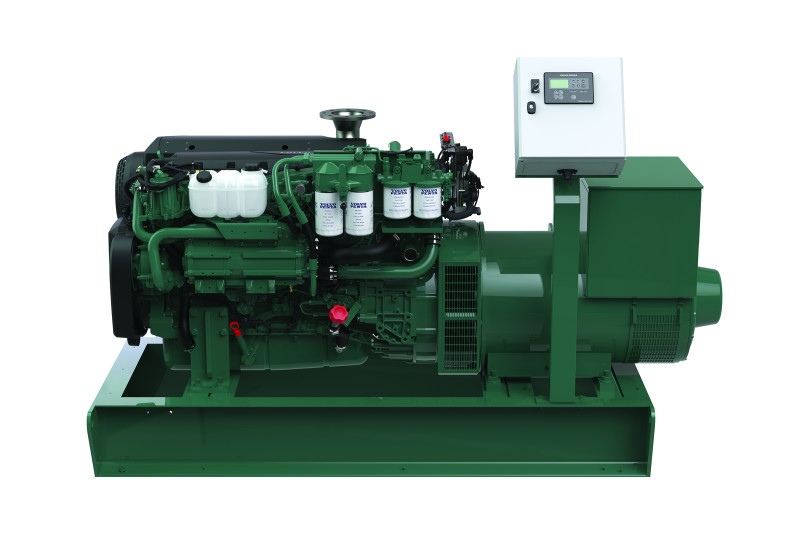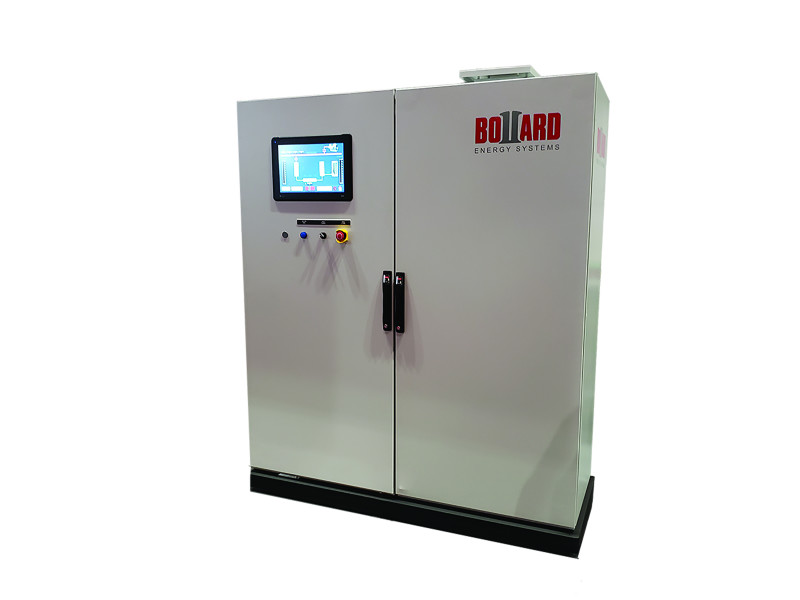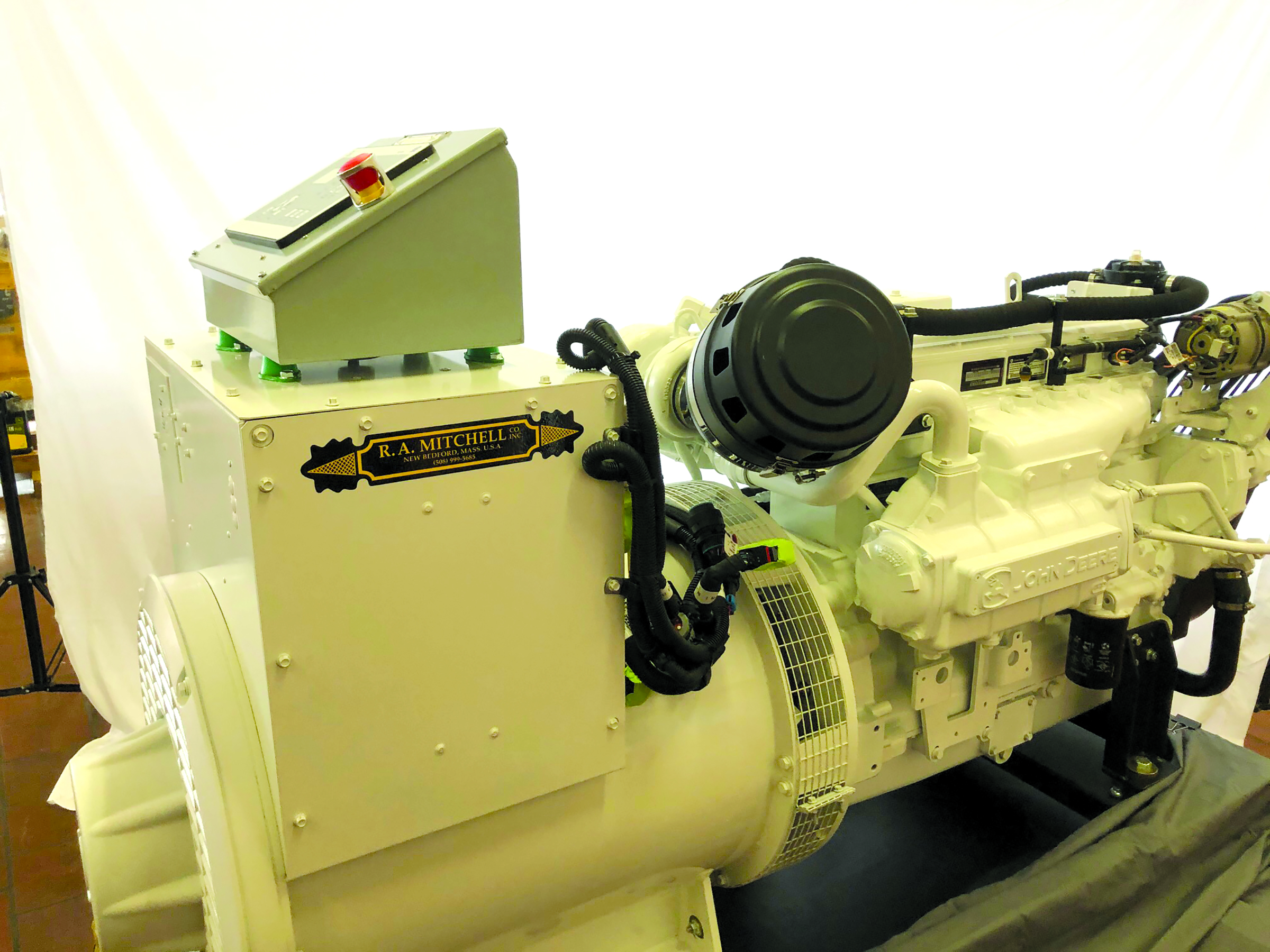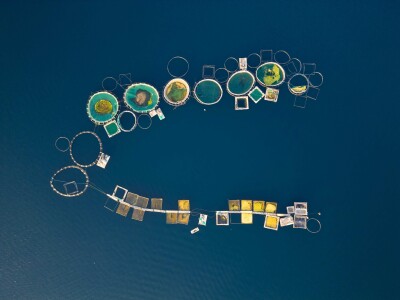Power onboard is a vital aspect of a successful fishing operation, and for newbuilds and repowering, boatowners need the right fit — along with reliability, serviceability, and regulatory compliance. A host of genset manufacturers are competing for various sectors of the commercial fishing vessel market, delivering gensets from 1.5 to hundreds of horsepower. Many manufacturers are using innovative engineering to combine various diesel engines with available generators. Other companies, such as Volvo-Penta, build all components of their gensets in-house, but all are pursuing increased efficiency through development of hybrid systems.
R.A. Mitchell Co. of New Bedford, Mass., has been building gensets since 1954. “Our brand is Ramco,”says Bob Mitchell, who took over the company from his father and now runs it with his daughter, Jen. “We have put gensets on over 500 fishing vessels,” he says, noting that the company is WBE and DBE certified (Women’s Business Enterprise and Disadvantage Business Enterprise), making it eligible to bid on federally assisted projects.
While R.A. Mitchell just introduced a 40-kW genset powered by a Tier III Yanmar 4TNV98, and makes a range of gensets up to 350-kW, the company’s most popular generator is its 150-kW unit.
“We mostly use John Deere, the 6068 AFM85, with a Marathon generator for that,” says Mitchell. “We’re one of the few OEM companies that package these John Deere and Yanmar commercial marine generator sets.”
Like most engines on the market, the John Deere is electronically controlled, and like many in the industry, Mitchell believes technological advances have made electronically controlled engines reliable. “As long as they’re handled correctly there’s no problem,” he says. “You shouldn’t disconnect the wiring once it’s been connected. That can send a harmonic down the wire and short circuit the system.”
According to Mitchell, reliability is also vital. “Any fishing boat that is 40, 50 or 200 miles offshore needs a genset that’s going to last 25,000 to 35,000 hours,” he says. “But the day it breaks the question is who is going to fix it and how fast? We had a guy in Connecticut whose 99-kW genset went down, and he needed a replacement. We had one on the floor ready to go and shipped it right out to him.”
Unique among genset manufacturers, Volvo-Penta makes its entire genset, the engine and the alternator. The company currently sells a D13 genset, and is in the process of bringing its D8 to the U.S. market.

“In the four years I’ve been here, I haven’t seen any D13s sold to commercial fishing boats,” says Rich Murdy, marine sales rep at Pacific Power Group. “But I think the D8 will open up more of that market for us.” In addition to taking advantage of the new Tier III genset, Murdy believes fishermen will benefit from Volvo-Penta being a single-source manufacturer. “It’s all under one warranty,” Murdy says.
Caterpillar, like many other companies, has developed hybrid systems primarily for tugboats. The company strives for efficiency in its gensets, using new technology. In 2019, Cat introduced its Multi-Engine Optimizer, a computerized system designed to maximize fuel efficiency up to 15 percent, reduce maintenance and cut emissions.
“Every engine has its sweet spot, the rpms for the best fuel burn,” says Chris Blazevich, Northwest sales rep for N.C. Power, a major Cat dealer. “The MEO monitors the burn and the power requirements of the vessel and balances the engines for optimum efficiency.” According to Blazevich, it can sometimes be better to meet the requirements of a 1,200-kW system, for example, with two 600-kW gensets, especially if it means staying clear of Tier IV after-treatment systems required to meet EPA emissions regulations.
So far Blazevich has not sold any Tier IV systems to fishing vessels, in spite of selling some hefty packages. “We put a 1,825-kW genset on one catcher-processor,” he says. “But that was before Tier IV requirements came into effect. Vessels can also petition for an exemption if they find they have to upgrade but cannot accommodate an after-treatment system. The regulations are designed to reduce emissions, not put people out of business.”
While Cat works with many Alaska boats with heavy power demands for processing and freezing, the company also makes gensets down to 1.5 kW. “Those are for a small boat that wants to add some chilling capacity or something,” says Blazevich.
Based in Seattle, MER Equipment makes a wide range of gensets under the brand name Bollard, from 8 up to 395 kW. “Mostly we use John Deere engines,” says Greg Sangster, former COO at MER and now hobby farmer on the east side of Washington’s Cascade Mountains. “But we started using Scania on the bigger gensets, and Kubota on the smallest ones.” Sangster notes that the most important thing is to get the right genset for the vessel. “You have to find out what the loads are — refrigeration, pumps, hotel, and all that. You have to size it correctly.”

When it comes time to choose a specific genset, sometimes the naval architect will make a recommendation, or yards will push a brand.
“I used to drive every year from San Diego to British Columbia talking to yards about our products,” says Sangster. “But sometimes the owner will say what they want. They might have experience with a certain brand, and that’s it.”
MER’s recent projects include putting a 200-kW Bollard genset on B&N Fisheries’ 115-foot vessel Arctic Wind. “We were tickled to get that,” Sangster says. Besides the basic genset, MER provided a SCOR (Sea Change Oil Regeneration) oil filtration system, Superflex exhaust, and a SeaDrive power take-off.
“We’re distributors for SCOR and Superflex,” says Sangster. “The SCOR system can remove particles less than 1 micron, and it removes water. And you know it’s not the oil that breaks down, it’s the additives. The SCOR system adds additives back in.” According to Sangster, the SCOR oil filtration can stretch time between oil changes up to 1,000 hours. “The Superflex exhaust can last five times longer than a regular bellows,” says Sangster. “The SeaDrive PTO can run your hydraulics and pumps. It’s our own design, we have 25 people working on R&D.”
One of the big R&D moves the company is making is toward hybrid technology. “Moving forward, we want to become the company that puts us out of business,” says Bob Allen, owner of MER. “We’re putting all our reserves into R&D that will get us off diesel fuel.” To that end, MER is looking at hybrid systems that would charge a battery bank that can kick in when loads are low.
“The battery picks up the load, or will load share with the engine until one or the other can shut down,” says Allen. “They will be programmed to find the most efficient combination of battery power and engine power.” But as Allen notes, you have to charge the batteries somehow, and MER is looking at hydrogen. “I think that’s our best bet. I’m looking forward to the day when carbon fuels are no longer viable, but for now we’re doing all we can to maximize economy and minimize emissions in our diesel engines.”
The idea of shifting high-capacity gensets offline when loads are low has been growing in popularity thanks to technological advances. Northern Lights, another Seattle-based company, has been pioneering variable-speed gensets. “They are adapted to follow the load,” says Don Williams, global sales manager at Northern Lights. The challenge with developing variable-speed gensets has been maintaining 60-Hz frequency at variable rpms. “To put it simply, the alternator produces what we call dirty AC,” says Williams. “We rectify that, turning it into DC and then, using an inverter, back into clean AC at a steady frequency.”
According to Williams, the variable-speed generators can run at 2,400 rpm under heavy loads and produce up to 40 percent more power. “They can also run at lower speeds so that overall the average rpms are lower than average,” he adds. The variable-speed gensets follow their optimum fuel curve at all times. As a component of a Northern Lights hybrid system, it’s possible to switch loads from the genset to battery banks. In no-load and low-load conditions, the engine operates only when the battery bank is depleted and only at the rpm required to satisfy the load.
Williams credits advances in inverter technology, mostly coming out of the auto industry, with driving change in new gensets. “This is nascent technology,” he says. “So far we have not done any hybrid projects with commercial fishing boats. We’d love to find partners to work with and develop systems that are specific to their needs. With hybrid there is so much versatility, I am sure we could find efficiencies.”







